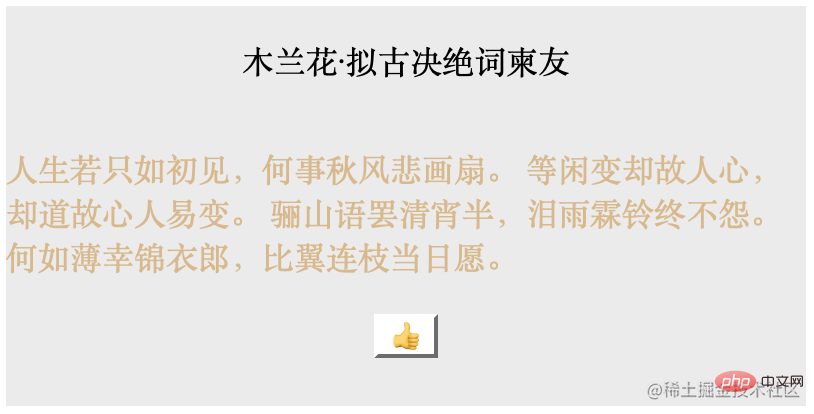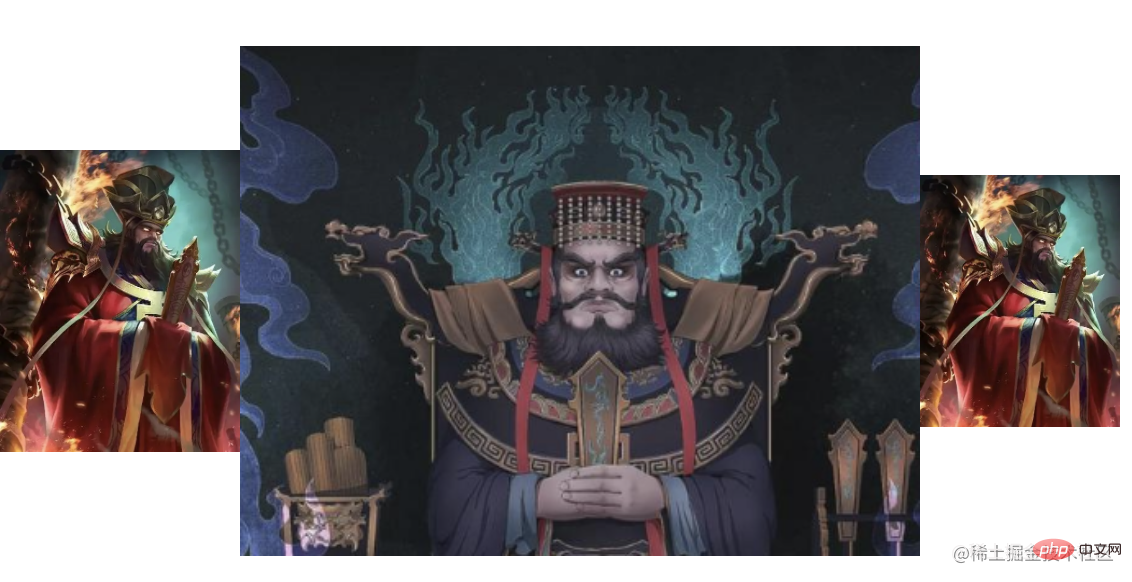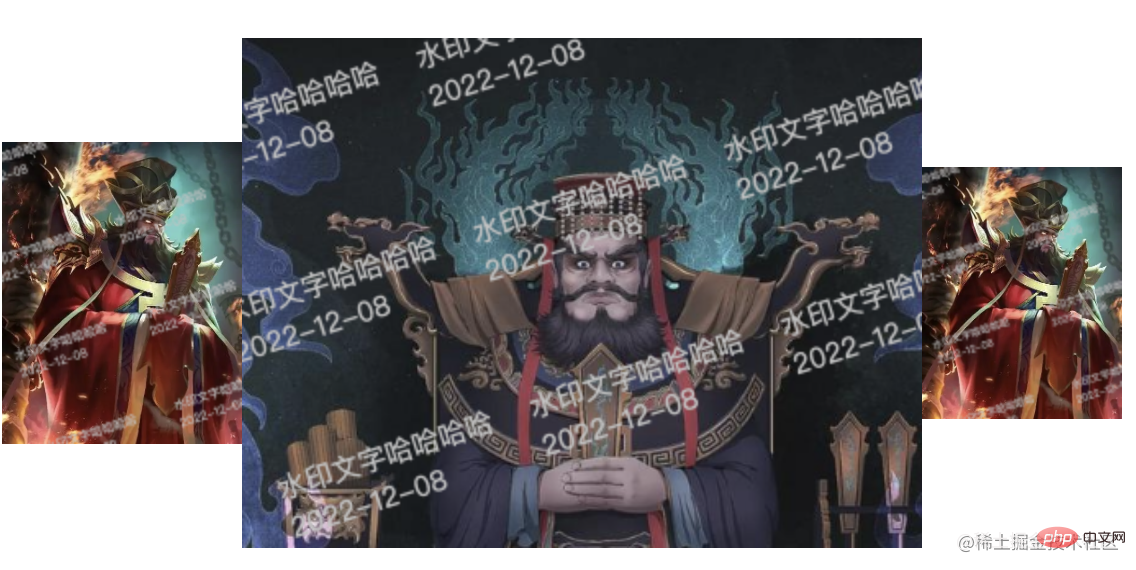 Web Front-end
Web Front-end
 JS Tutorial
JS Tutorial
 Detailed explanation of how to use JS to achieve overlay watermark effect
Detailed explanation of how to use JS to achieve overlay watermark effect
Detailed explanation of how to use JS to achieve overlay watermark effect
Nonsense start: simply implement a small function to cover watermarks. Watermarks are usually added to pictures, and then directly load the processed pictures url. The pictures are not modified here. Instead, directly add a canvas mask to the dom to be added.
1. Effect
Before processing
DIV

IMG

After processing
DIV


DIV, the button click event will not be blocked by the mask. And cannot click
2. JS code
class WaterMark{
//水印文字
waterTexts = []
//需要添加水印的dom集合
needAddWaterTextElementIds = null
//保存添加水印的dom
saveNeedAddWaterMarkElement = []
//初始化
constructor(waterTexts,needAddWaterTextElementIds){
if(waterTexts && waterTexts.length != 0){
this.waterTexts = waterTexts
} else {
this.waterTexts = ['水印文字哈哈哈哈','2022-12-08']
}
this.needAddWaterTextElementIds = needAddWaterTextElementIds
}
//开始添加水印
startWaterMark(){
const self = this
if(this.needAddWaterTextElementIds){
this.needAddWaterTextElementIds.forEach((id)=>{
let el = document.getElementById(id)
self.saveNeedAddWaterMarkElement.push(el)
})
} else {
this.saveNeedAddWaterMarkElement = Array.from(document.getElementsByTagName('img'))
}
this.saveNeedAddWaterMarkElement.forEach((el)=>{
self.startWaterMarkToElement(el)
})
}
//添加水印到到dom对象
startWaterMarkToElement(el){
let nodeName = el.nodeName
if(['IMG','img'].indexOf(nodeName) != -1){
//图片,需要加载完成进行操作
this.addWaterMarkToImg(el)
} else {
//普通,直接添加
this.addWaterMarkToNormalEle(el)
}
}
//给图片添加水印
async addWaterMarkToImg(img){
if(!img.complete){
await new Promise((resolve)=>{
img.onload = resolve
})
}
this.addWaterMarkToNormalEle(img)
}
//给普通dom对象添加水印
addWaterMarkToNormalEle(el){
const self = this
let canvas = document.createElement('canvas')
canvas.width = el.width ? el.width : el.clientWidth
canvas.height = el.height ? el.height : el.clientHeight
let ctx = canvas.getContext('2d')
let maxSize = Math.max(canvas.height, canvas.width)
let font = (maxSize / 25)
ctx.font = font + 'px "微软雅黑"'
ctx.fillStyle = "rgba(195,195,195,1)"
ctx.textAlign = "left"
ctx.textBaseline = "top"
ctx.save()
let angle = -Math.PI / 10.0
//进行平移,计算平移的参数
let translateX = (canvas.height) * Math.tan(Math.abs(angle))
let translateY = (canvas.width - translateX) * Math.tan(Math.abs(angle))
ctx.translate(-translateX / 2.0, translateY / 2.0)
ctx.rotate(angle)
//起始坐标
let x = 0
let y = 0
//一组文字之间间隔
let sepY = (font / 2.0)
while(y < canvas.height){
//当前行的y值
let rowCurrentMaxY = 0
while(x < canvas.width){
let totleMaxX = 0
let currentY = 0
//绘制水印
this.waterTexts.forEach((text,index)=>{
currentY += (index * (sepY + font))
let rect = self.drawWater(ctx,text,x,y + currentY)
let currentMaxX = (rect.x + rect.width)
totleMaxX = (currentMaxX > totleMaxX) ? currentMaxX: totleMaxX
rowCurrentMaxY = currentY
})
x = totleMaxX + 20
}
//重置x,y值
x = 0
y += (rowCurrentMaxY + (sepY + font + (canvas.height / 5)))
}
ctx.restore()
//添加canvas
this.addCanvas(canvas,el)
}
//绘制水印
drawWater(ctx,text,x,y){
//绘制文字
ctx.fillText(text,x,y)
//计算尺度
let textRect = ctx.measureText(text)
let width = textRect.width
let height = textRect.height
return {x,y,width,height}
}
//添加canvas到当前标签的父标签上
addCanvas(canvas,el){
//创建div(canvas需要依赖一个div进行位置设置)
let warterMarDiv = document.createElement('div')
//关联水印dom对象
el.warterMark = warterMarDiv
//添加样式
this.resetCanvasPosition(el)
//添加水印
warterMarDiv.appendChild(canvas)
//添加到父标签
el.parentElement.insertBefore(warterMarDiv,el)
}
//重新计算位置
resetCanvasPosition(el){
if(el.warterMark){
//设置父标签的定位
el.parentElement.style.cssText = `position: relative;`
//设施水印载体的定位
el.warterMark.style.cssText = 'position: absolute;top: 0px;left: 0px;pointer-events:none'
}
}
}<div>
<!-- 待加水印的IMG -->
<img src="/static/imghw/default1.png" data-src="" alt=" class="lazy" style="max-width:90%" alt="">
</div>
let waterMark = new WaterMark()
waterMark.startWaterMark();ctx.save() and ctx .restore() In fact, it is not very useful here, but it is still added. The purpose is to save the context before adding the watermark, and to restore the context before the watermark after finishing drawing. In this way, these italicized words are only in these two It takes effect between lines of code. If you draw other lines below, it will not be affected.
To prevent the mask watermark from blocking underlying buttons or other events, you need to add thepointer-events:none attribute to the mask label.
You need to add aparent tag outside the label to add the watermark. The function of this parent tag is to add constraints to the position of the mask canvas, here I wanted to use MutationObserver to observe changes in body to update the position of maskcanvas. This attempt failed because as long as the complex layout changes, it will be in this callback. trigger in. Therefore, you need to add a parent tag directly outside the tag where the watermark is added, and use this parent tag to automatically constrain the position of the maskcanvas.
MutationObserver The logic is as follows. You can modify the layout or other operations in time in the listening callback (give up temporarily).
var MutationObserver = window.MutationObserver || window.webkitMutationObserver || window.MozMutationObserver;
var mutationObserver = new MutationObserver(function (mutations) {
//修改水印位置
})
mutationObserver.observe(document.getElementsByTagName('body')[0], {
childList: true, // 子节点的变动(新增、删除或者更改)
attributes: true, // 属性的变动
characterData: true, // 节点内容或节点文本的变动
subtree: true // 是否将观察器应用于该节点的所有后代节点
})IMG, you need to observe its complete event.
3. Summary and thinking
Usecanvas ctx.drawImage(img, 0, 0) to draw, and then canvas .toDataURL('image/png') Loading the generated url to the previous image is also a way. However, sometimes the final composite image will be ## because of the image. #base64 The data is empty, so adding a mask directly is just for display, not to generate a real composite image. A simple pseudo-watermark has been implemented. There is no particularly complicated code. The code is clumsy. Gods should not laugh. 》
The above is the detailed content of Detailed explanation of how to use JS to achieve overlay watermark effect. For more information, please follow other related articles on the PHP Chinese website!

Hot AI Tools

Undresser.AI Undress
AI-powered app for creating realistic nude photos

AI Clothes Remover
Online AI tool for removing clothes from photos.

Undress AI Tool
Undress images for free

Clothoff.io
AI clothes remover

Video Face Swap
Swap faces in any video effortlessly with our completely free AI face swap tool!

Hot Article

Hot Tools

Notepad++7.3.1
Easy-to-use and free code editor

SublimeText3 Chinese version
Chinese version, very easy to use

Zend Studio 13.0.1
Powerful PHP integrated development environment

Dreamweaver CS6
Visual web development tools

SublimeText3 Mac version
God-level code editing software (SublimeText3)

Hot Topics
 1669
1669
 14
14
 1428
1428
 52
52
 1329
1329
 25
25
 1273
1273
 29
29
 1256
1256
 24
24
 WebSocket and JavaScript: key technologies for implementing real-time monitoring systems
Dec 17, 2023 pm 05:30 PM
WebSocket and JavaScript: key technologies for implementing real-time monitoring systems
Dec 17, 2023 pm 05:30 PM
WebSocket and JavaScript: Key technologies for realizing real-time monitoring systems Introduction: With the rapid development of Internet technology, real-time monitoring systems have been widely used in various fields. One of the key technologies to achieve real-time monitoring is the combination of WebSocket and JavaScript. This article will introduce the application of WebSocket and JavaScript in real-time monitoring systems, give code examples, and explain their implementation principles in detail. 1. WebSocket technology
 PHP and Vue: a perfect pairing of front-end development tools
Mar 16, 2024 pm 12:09 PM
PHP and Vue: a perfect pairing of front-end development tools
Mar 16, 2024 pm 12:09 PM
PHP and Vue: a perfect pairing of front-end development tools. In today's era of rapid development of the Internet, front-end development has become increasingly important. As users have higher and higher requirements for the experience of websites and applications, front-end developers need to use more efficient and flexible tools to create responsive and interactive interfaces. As two important technologies in the field of front-end development, PHP and Vue.js can be regarded as perfect tools when paired together. This article will explore the combination of PHP and Vue, as well as detailed code examples to help readers better understand and apply these two
 JavaScript and WebSocket: Building an efficient real-time weather forecasting system
Dec 17, 2023 pm 05:13 PM
JavaScript and WebSocket: Building an efficient real-time weather forecasting system
Dec 17, 2023 pm 05:13 PM
JavaScript and WebSocket: Building an efficient real-time weather forecast system Introduction: Today, the accuracy of weather forecasts is of great significance to daily life and decision-making. As technology develops, we can provide more accurate and reliable weather forecasts by obtaining weather data in real time. In this article, we will learn how to use JavaScript and WebSocket technology to build an efficient real-time weather forecast system. This article will demonstrate the implementation process through specific code examples. We
 Is Django front-end or back-end? check it out!
Jan 19, 2024 am 08:37 AM
Is Django front-end or back-end? check it out!
Jan 19, 2024 am 08:37 AM
Django is a web application framework written in Python that emphasizes rapid development and clean methods. Although Django is a web framework, to answer the question whether Django is a front-end or a back-end, you need to have a deep understanding of the concepts of front-end and back-end. The front end refers to the interface that users directly interact with, and the back end refers to server-side programs. They interact with data through the HTTP protocol. When the front-end and back-end are separated, the front-end and back-end programs can be developed independently to implement business logic and interactive effects respectively, and data exchange.
 Exploring Go language front-end technology: a new vision for front-end development
Mar 28, 2024 pm 01:06 PM
Exploring Go language front-end technology: a new vision for front-end development
Mar 28, 2024 pm 01:06 PM
As a fast and efficient programming language, Go language is widely popular in the field of back-end development. However, few people associate Go language with front-end development. In fact, using Go language for front-end development can not only improve efficiency, but also bring new horizons to developers. This article will explore the possibility of using the Go language for front-end development and provide specific code examples to help readers better understand this area. In traditional front-end development, JavaScript, HTML, and CSS are often used to build user interfaces
 Simple JavaScript Tutorial: How to Get HTTP Status Code
Jan 05, 2024 pm 06:08 PM
Simple JavaScript Tutorial: How to Get HTTP Status Code
Jan 05, 2024 pm 06:08 PM
JavaScript tutorial: How to get HTTP status code, specific code examples are required. Preface: In web development, data interaction with the server is often involved. When communicating with the server, we often need to obtain the returned HTTP status code to determine whether the operation is successful, and perform corresponding processing based on different status codes. This article will teach you how to use JavaScript to obtain HTTP status codes and provide some practical code examples. Using XMLHttpRequest
 Django: A magical framework that can handle both front-end and back-end development!
Jan 19, 2024 am 08:52 AM
Django: A magical framework that can handle both front-end and back-end development!
Jan 19, 2024 am 08:52 AM
Django: A magical framework that can handle both front-end and back-end development! Django is an efficient and scalable web application framework. It is able to support multiple web development models, including MVC and MTV, and can easily develop high-quality web applications. Django not only supports back-end development, but can also quickly build front-end interfaces and achieve flexible view display through template language. Django combines front-end development and back-end development into a seamless integration, so developers don’t have to specialize in learning
 Questions frequently asked by front-end interviewers
Mar 19, 2024 pm 02:24 PM
Questions frequently asked by front-end interviewers
Mar 19, 2024 pm 02:24 PM
In front-end development interviews, common questions cover a wide range of topics, including HTML/CSS basics, JavaScript basics, frameworks and libraries, project experience, algorithms and data structures, performance optimization, cross-domain requests, front-end engineering, design patterns, and new technologies and trends. . Interviewer questions are designed to assess the candidate's technical skills, project experience, and understanding of industry trends. Therefore, candidates should be fully prepared in these areas to demonstrate their abilities and expertise.



